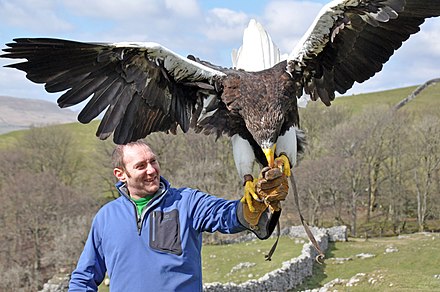Steller’s Sea Eagles (Haliaeetus pelagicus) are one of the largest and most powerful eagle species in the world, known for their striking appearance and impressive hunting skills. While these majestic birds are primarily diurnal hunters, there is some evidence that they may engage in nocturnal feeding opportunistically, especially during the winter months.
Steller’s Sea Eagles: Daytime Hunters
Steller’s Sea Eagles are known to be primarily diurnal hunters, using their keen eyesight to spot fish, crabs, shellfish, and other prey from perches or while soaring in the sky. They are opportunistic feeders, preying on a variety of aquatic and terrestrial animals, including:
- Salmon (in their breeding grounds)
- Cod (in Japan)
- Crabs and shellfish
- Squid
- Small mammals and birds
- Carrion
These eagles are skilled at diving into the water to catch fish, and they are also known to steal prey from other birds, such as gulls.
Nocturnal Feeding Opportunities
 Image source: stellers sea eagle
Image source: stellers sea eagle
While Steller’s Sea Eagles are primarily diurnal hunters, there is some evidence that they may engage in nocturnal feeding opportunistically, especially during the winter months when they migrate to Japan and the days are shorter.
Hunting in Low Light Conditions
Steller’s Sea Eagles have excellent low-light vision, which may allow them to hunt at dawn, dusk, or even during the night. This could be particularly useful during the winter months when their prey, such as cod, may be more active at night.
Scavenging Opportunities
In addition to hunting, Steller’s Sea Eagles are known to be opportunistic scavengers. They may take advantage of nighttime conditions to feed on carrion or other food sources that are more accessible during the night.
Migratory Behavior
During the winter months, Steller’s Sea Eagles migrate to Japan, where they may encounter different prey and feeding opportunities compared to their breeding grounds in Russia. This change in environment and prey availability may lead to more nocturnal feeding behavior.
Factors Influencing Nocturnal Hunting
Several factors may influence the likelihood of Steller’s Sea Eagles engaging in nocturnal hunting:
-
Prey Availability: If their primary prey, such as fish or crabs, are more active or accessible at night, the eagles may be more inclined to hunt during these hours.
-
Environmental Conditions: Factors like weather, moonlight, and the presence of artificial lighting may affect the eagles’ ability to hunt effectively at night.
-
Individual Behavior: As with any species, individual Steller’s Sea Eagles may exhibit varying degrees of nocturnal activity based on their own preferences and experiences.
Conclusion
In conclusion, while Steller’s Sea Eagles are primarily diurnal hunters, there is some evidence that they may engage in nocturnal feeding opportunistically, especially during the winter months when they migrate to Japan. Their excellent low-light vision and ability to scavenge may allow them to take advantage of nighttime conditions and food sources. However, the extent and frequency of their nocturnal hunting behavior is not well-documented, and further research is needed to fully understand this aspect of their hunting strategies.

